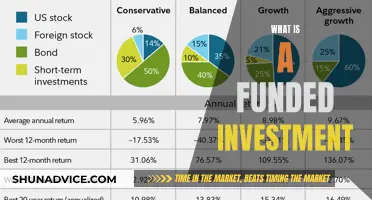
Exchange-traded funds (ETFs) are a type of investment fund that combines the benefits of stocks and mutual funds. They offer the diversification of mutual funds and the ease of stock trading. ETFs are a basket of securities, such as stocks or bonds, that trade on an exchange like stocks. They provide instant diversification by investing in multiple assets at once and often have lower fees than other types of funds. ETFs are ideal for investors looking to broaden their portfolio without increasing the time and effort spent on managing and allocating their investments. They are perfect for beginners to get started with investing and can generate impressive returns without requiring much expense or effort.
| Characteristics | Values |
|---|---|
| Type of investment fund | Exchange-traded fund (ETF) |
| Investment style | Passive or active |
| Investment objective | Income generation, speculation, price increases, hedging or offsetting risk |
| Investment diversification | Instant diversification by investing in many assets at once |
| Investment access | Exposure to companies that may otherwise be inaccessible |
| Investment costs | Lower fees than other types of funds |
| Liquidity | More liquid (easier to buy and sell) than mutual funds |
| Management | No management required |
| Tax efficiency | More tax-efficient than mutual funds |
What You'll Learn

ETFs are low-cost and low-risk
Exchange-traded funds (ETFs) are a great investment vehicle for small and large investors alike. They are a type of index fund that combines the best attributes of stocks and mutual funds. ETFs are an excellent way to begin investing, especially for beginners, as they are fairly simple to understand and can generate impressive returns without requiring much expense or effort.
ETFs are also more tax-efficient than mutual funds. As passively managed portfolios, ETFs tend to realise fewer capital gains than actively managed mutual funds. Mutual funds are required to distribute capital gains to shareholders if the fund manager sells securities for a profit. This distribution amount is made based on the proportion of the holders' investment and is taxable. ETFs, on the other hand, can be more tax-efficient since they are traded like stocks, and most buying and selling occur through an exchange, reducing tax costs.
ETFs are low-risk investments because they hold a basket of stocks or other securities, increasing diversification. They provide instant diversification by investing in many assets at once, and they can be designed to track specific investment strategies. The first ETF was the SPDR S&P 500 ETF (SPY), which tracks the S&P 500 Index. ETFs can be structured to track anything from the price of a commodity to a diverse collection of securities. They can also be used to hedge or partly offset risk in an investor's portfolio.
ETFs are more liquid and easier to buy and sell than mutual funds. They can be purchased on margin and sold short, and they may serve as underlying securities for option contracts. The most popular ETFs trade with more liquidity than most stocks, meaning there are plenty of buyers and sellers and narrow bid-ask spreads.
ETFs are an excellent way to gain exposure to a variety of stocks, bonds, and other assets, typically at a minimal expense. They are a cost-effective way to gain exposure to a broad basket of securities with a limited budget. Investors can build a well-diversified portfolio with a single ETF or a combination of multiple ETFs targeting different industries, sectors, or asset classes.
Index Funds: Risky Business or Smart Investing?
You may want to see also

They offer instant diversification
Exchange-traded funds (ETFs) are a great way to instantly diversify your portfolio. ETFs are baskets of stocks or bonds that trade on an exchange just like a stock. This means that investors can buy shares of ETFs, and the money is used to invest according to a certain objective. For example, if you buy an S&P 500 ETF, your money will be invested in the 500 companies in that index.
ETFs provide instant diversification by investing in many assets at once. This means that investors can gain exposure to a variety of stocks, bonds, and other assets, typically at a minimal expense. ETFs take the guesswork out of stock investing and allow investors to match the market's performance over time.
ETFs are also more liquid and easier to buy and sell than mutual funds. Online brokers make it simple to purchase or sell ETFs with just a click of the mouse. Additionally, it can be extremely complicated to invest in individual bonds, but a bond ETF can make the fixed-income portion of your portfolio very easy.
ETFs are a great way to instantly diversify your portfolio and gain exposure to a wide range of assets. They are simple to understand and can generate impressive returns without much expense or effort.
Bond Funds: Risky Business, Not Worth Your Investment
You may want to see also

They're easy to buy and sell
Exchange-traded funds (ETFs) are easy to buy and sell for several reasons. Firstly, they trade on major exchanges such as the NYSE and Nasdaq, just like stocks. This means that investors can buy and sell ETFs whenever the stock market is open, and the process is straightforward and instantaneous. In contrast, mutual funds are priced once per day and transactions are not immediate, as they are typically purchased through a brokerage or the issuer.
Secondly, ETFs are more liquid than mutual funds, meaning they are easier to buy and sell. Online brokers make trading ETFs simple, as investors can buy or sell with just a click of the mouse.
Thirdly, ETFs are available on most online investing platforms, retirement account provider sites, and investing apps, many of which offer commission-free trading. This means that investors do not have to pay fees to the platform providers to buy or sell ETFs.
Lastly, ETFs are fairly simple to understand, even for beginner investors. They allow investors to buy many stocks or bonds at once, providing exposure to a variety of stocks, bonds, and other assets, typically at a minimal expense.
Choosing a Location for Your Offshore Investment Fund Office
You may want to see also

They can be more tax-efficient than mutual funds
Exchange-traded funds (ETFs) are a type of investment fund that combines the best attributes of stocks and mutual funds. They are a basket of securities that can be traded on an exchange like stocks, but they also provide the diversification benefits of mutual funds. ETFs can be more tax-efficient than mutual funds due to several reasons:
- ETFs, as passively managed portfolios, tend to realise fewer capital gains than actively managed mutual funds. Mutual funds are required to distribute capital gains to shareholders if the fund manager sells securities for a profit, and this distribution is taxable for the shareholders. In contrast, ETFs do not need to distribute capital gains as frequently, resulting in lower tax liability for their investors.
- ETFs are traded on exchanges, and their prices are determined by market forces throughout the trading day. This means that there is less chance of their share prices being higher or lower than the net asset value of the underlying shares. Arbitrage opportunities will ensure that the ETF price remains close to the value of the underlying securities. In contrast, mutual funds are priced only once a day after the market closes, and there is more uncertainty about the redemption price for investors.
- ETFs generally have lower expense ratios than actively managed mutual funds. Mutual funds tend to have higher expense ratios due to management fees, fund accounting and trading expenses, and load fees related to their sale and distribution.
- ETFs provide the benefit of immediate reinvestment of dividends, whereas the timing for reinvestment in mutual funds can vary.
Overall, ETFs can be a more tax-efficient option than mutual funds due to their passive management structure, intraday trading, lower expense ratios, and immediate dividend reinvestment.
Key Factors to Consider Before Investing in Mutual Funds
You may want to see also

They can be used to hedge or offset risk
Exchange-traded funds (ETFs) are a great way to hedge or offset risk. Here's how:
Diversification
ETFs are a basket of securities that can track a specific index, industry, sector, or broad market index. This allows investors to gain exposure to a wide range of stocks or bonds, reducing the risk associated with individual securities. By investing in an ETF, you can easily diversify your portfolio, which helps to lower your overall risk.
Low Volatility
ETFs that track a broad market index, such as the S&P 500, tend to be less volatile than those focused on specific sectors or industries. This means that the value of the ETF is less likely to fluctuate drastically, reducing the risk of significant losses.
Low Costs
ETFs often have lower fees and expense ratios than other types of funds, such as mutual funds. This means that more of your investment goes towards generating returns, rather than paying fees. Lower costs can lead to higher overall returns and a reduced risk of losing money due to high fees.
Tax Efficiency
ETFs can be more tax-efficient than other investment options. For example, ETFs generally realize fewer capital gains than actively managed mutual funds, resulting in lower capital gains taxes for investors. Additionally, ETFs that reinvest dividends can help investors avoid immediate tax liabilities.
Flexibility
ETFs trade on major exchanges and can be bought and sold throughout the trading day, just like stocks. This flexibility allows investors to react quickly to market changes and make timely decisions to manage their risk.
Risk Mitigation Strategies
Certain types of ETFs are specifically designed to hedge or offset risk. For example, inverse ETFs move in the opposite direction of their reference index, providing a hedge against market declines. While these strategies can be risky and complex, they offer advanced investors tools to manage their risk exposure.
Arbitrage Funds: A Smart Investment Strategy for Asian Investors
You may want to see also







